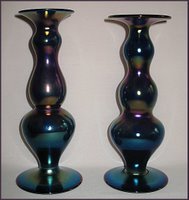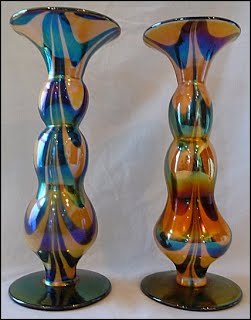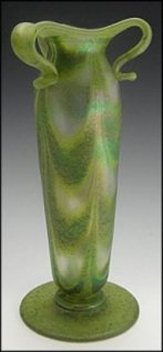Time & Place at Imperial
From an old Imperial catalog: "Free Hand, made by the hands of an artist, no molds or forms of any kind used. . .
 |
 |
. . . and no two pieces alike." |
Free Hand was introduced in 1923. A June 7th, 1923 article in the Crockery & Glass Journal heralded "New Imperial Line Rivals World's Finest Glassware" and a design patent for the FH paper label was obtained on December 12th, 1923.
It was initially produced by a handful of men, some of whom had originally immigrated from Sweden. Emil Larson, born in Sweden, in 1878 and William Wedenbine, born in Pennsylvania in 1885, were prominent among them, as was Oscar Ekstedt. Wedenbine or Ekstedt appears to have headed the group, Larson only staying at Imperial for two months, October to December 1923. Being very expensive to produce and subsequently buy (in 1924 a Free Hand vase was $25 retail while a box of Kellogg's Corn Flakes cost 9 cents), sales were poor and Free Hand was not a financial success. When Wedenbine left in December, 1924 it appears production ceased. Thus Free Hand was only made for a little more than one year.
Looking for a cheaper alternative, Lead Lustre, made in paste molds before being decorated/finished, was introduced the next month, in January 1925. The Supplement to Imperial’s Bargain Book served to announce Lead Lustre to the marketplace and an advertisement for Lead Lustre appeared in China, Glass & Lamps on January 12, 1925. Some of it was decorated to resemble Free Hand but whereas wholesale Free Hand had sold 12 pieces for $50.00, the same $50.00 got you 25 pieces of Lead Lustre.
In 1926 Imperial Catalog 201 offered Lead Lustre vases but the selection was left up to Imperial, not the customer. This likely signified a closeout sale and that production had stopped. Lead Lustre doesn't appear in any subsequent Imperial catalogs. Thus Lead Lustre was only made for a little more than one year also,although remaining inventory is believed to have been sold as late as 1929.
The foregoing is an extremely brief look at the Imperial art glass story. For a comprehensive history of the Imperial Glass Company, including Free Hand and Lead Lustre, please click here.

